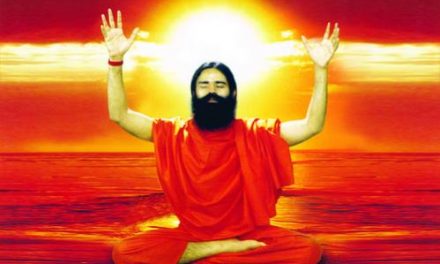The energy that flows out of our body through Yog asana, pranayama and bandha is stopped and taken in. bandha means to stop, controlling. These bandhas are very helpful in pranayama. Pranayama is incomplete without these bandhas. Here the different bandhas are being described.
Jalandhar Bandha:
Sit in Padmasana or Siddhasana and breath in. keep the hands on the knees. Bend the chin downwards and try to touch the neck point. This is known as Jalandhar bandha. Focus in between the eyebrows. The chest should be stretched forwards. This bandha controls the network of nerves in the neck area.
Benefits:
It makes the throat sweet, melodious and attractive.
Contraction of throat and closure of Ida and pingla nerves helps the prana or vital life energy to enter sushmana.
It is beneficial in all throat diseases. It should be practiced in case of thyroid and tonsils.
It arouses Vishudhi chakra.
Uddiyan Bandha:
The bandha, which arouses prana and helps it in entering sushmana, is known as Uddiyan Bandha. Stand straight and keep both the hands on the knees. Breath out and relax the stomach. Do Jalandhar bandha and raise the chest slightly upwards. Contract the stomach inside as much as possible. Breathe in and repeat the above procedure. Practice it three times in the beginning. The practice should be increased gradually. This bandha can be done sitting in Padmasana or Siddhasana.
Benefits:
It cures all stomach related problems.
It arouses the prana and purifies the Manipur chakra or solar Plexus.
Moolbandha:
Sit in Siddhasana or Padmasana and doBahya or Abhyantar Kumbhak, pull up the rectum and genitals. In this bandha the area below the navel gets contracted. This bandha should be done with Bahya Kumbhak. Some practitioners do it for several hours very easily. It should be practiced for long hours under the guidance of a qualified Yog teacher.
Benefits:
The apana vayu moves up and synchronizes with prana or vital life energy. It arouses the Mooladhar chakra or Pelvic Plexus and arouses the kundalini.
It cures constipation and piles and increases digestive fire.
It helps in upward movement of semen and it is very important for following celibacy.
Mahabandha:
Sit in Padmasana or any meditative pose and do all the three bandhas at a time. This is known as Mahabandha. All the benefits mentioned above are obtained with its practice. All these three bandhas are applied in case of Kumbhak.
Benefits:
The prana move upwards.
It purifies the semen and increases strength.
Mahabandha helps in the convergence of Ida, Pingla and sushmana.
Right posture for pranayama:
The spine should be absolutely straight at the time of practicing pranayama. Sit in any meditative pose like Siddhasana, Padmasana, Sukhasana, Vajrasana etc. If you cannot sit in any asana, then sit straight on a chair and practice pranayama. The spine should be straight; it should not bend at any place. Nowadays, we see people practicing pranayama in any posture, walking, or standing position. But this is not correct. This could be very harmful at some point of time. Pranayama arouses the vital life energy and all the centers related to the spine. Therefore, it is necessary to sit straight while practicing pranayama. Practicing pranayama in a sitting position helps in concentration.








